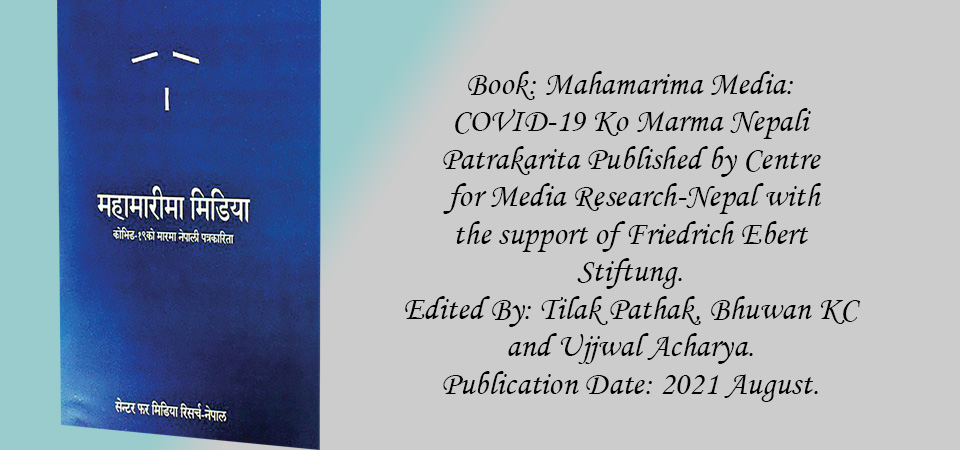Media Needs Disaster Preparedness

Modnath Dhakal
The COVID-19 pandemic battered every sector of society and economy. Even the health and food industry suffered during the first wave of the disease. Information was the most sought after commodity during the initial days of the pandemic and the need and hunger for information about it massively increased when the country went into lockdown on 24 March 2020. The virus was new and no one knew much about it, including the health professionals except some virologists, let alone journalists and media.
Fear reigned supreme as people were afraid to open their windows while many families hoarded foods and medicines more than they required. Although the infection and death rates were low, all activities were curtailed and movements restricted. But journalists were required to venture out, for it was their responsibility and their profession demanded this.
Meanwhile, the economic activities, events and public relations activities suddenly came to a halt, most of the media outlets were in confusion about their next move in content generation, reaching out to the audience and connecting with the sources of information. Hundreds of newspapers and magazines shut down while radios and televisions opted for the repeated broadcast of programmes. For the immediate update of news and information, people resorted to the Internet. People were swiping up and down in their handheld devices to quench their thirst for information.
Two things happened simultaneously. One, large media houses, primarily the newspapers and magazines cut down the number of journalists and other staff. Two, the journalists who were deprived of their jobs due to the pandemic launched their online news portals. This happened with reporters to chief editors of the reputed media houses. Although the future of a large number of online media is uncertain, it has been sheltering hundreds of journalists since then.
To portray the hardships that the media underwent during and in the immediate aftermath of the pandemic, the Centre for Media Research has published a collection of research reports -' Mahamarima Media: COVID-19 ko Marma Nepali Patrakarita' - covering the impact of COVID-19 in all seven provinces in the country. It concluded that all the media had faced economic challenges and working journalists were the ones who were most suffered. During the lockdown, most of the print media were closed, advertising was difficult to find, income went down, journalists were fired with various excuses, those who continue to work with the media got a small portion of their salary, and many journalists worked without salary.
The research also found that since lockdown and safety concerns drastically reduced the mobility of the media people, it not only affected the collection of information but also directly decreased the quality of the news. While most journalists were involved in news collection, processing and publication during difficult times, many of them said that there was confusion about the future of journalism. On the other hand, media owners, including the self-employed ones, said that sustaining the media was the most important thing during the pandemic, and salary and other facilities were the secondary issues.
The study found that Nepali media do not have disaster preparedness. They were helpless during the earthquake and they were helpless during the COVID-19. There is no agency or fund to support them when they are in trouble. There are no resources to be mobilised when journalists in media houses need it. On the contrary, small support extended by the government to the media did not reach the working journalists. Media owners did not consider it their duty to support their employees during the pandemic. Many organisations such as non-government organisations, provincial and local government, Federation of Nepalese Journalists provided little support to selected media houses but since the number of outlets was high, the support was not enough to meet the basic requirement.
The pathetic part of this all was the lack of sincerity on the part of media owners in tackling the crisis and managing the human resources. Instead, they immediately fired a significant number of journalists, holding many with a fraction of their monthly payments, and some were asked to go on an unpaid forced to leave. The owners were the least concerned about the social security of the journalists and many did not offer the facility of COVID-19 insurance to their media personnel.
Prepared with the content collected through interviews with 146 journalists and media owners in seven provinces, this book has documented the plight of journalists in the time of the COVID-19 pandemic. In eight chapters, it describes the situation before mid-December 2020. It shows that the situation of journalists in all provinces was the same but media people affiliated with the print media were the most affected, followed by television and radio. The book has archival value and provides useful information about the situation of journalists and media in Nepal during the first wave of the pandemic before the economy and society returned to normalcy.
Recent News

Do not make expressions casting dout on election: EC
14 Apr, 2022
CM Bhatta says may New Year 2079 BS inspire positive thinking
14 Apr, 2022
Three new cases, 44 recoveries in 24 hours
14 Apr, 2022
689 climbers of 84 teams so far acquire permits for climbing various peaks this spring season
14 Apr, 2022
How the rising cost of living crisis is impacting Nepal
14 Apr, 2022
US military confirms an interstellar meteor collided with Earth
14 Apr, 2022
Valneva Covid vaccine approved for use in UK
14 Apr, 2022
Chair Prachanda highlights need of unity among Maoist, Communist forces
14 Apr, 2022
Ranbir Kapoor and Alia Bhatt: Bollywood toasts star couple on wedding
14 Apr, 2022
President Bhandari confers decorations (Photo Feature)
14 Apr, 2022











